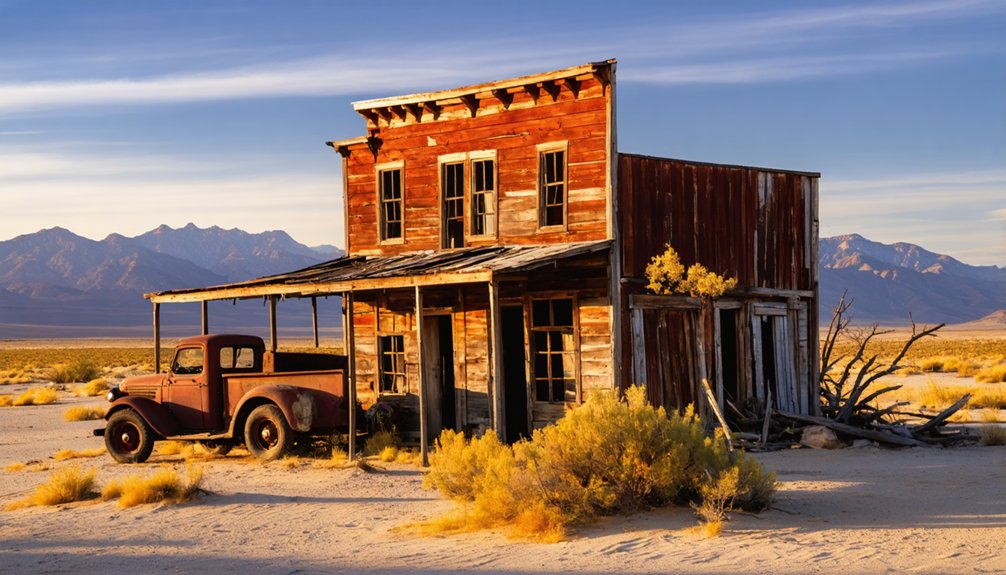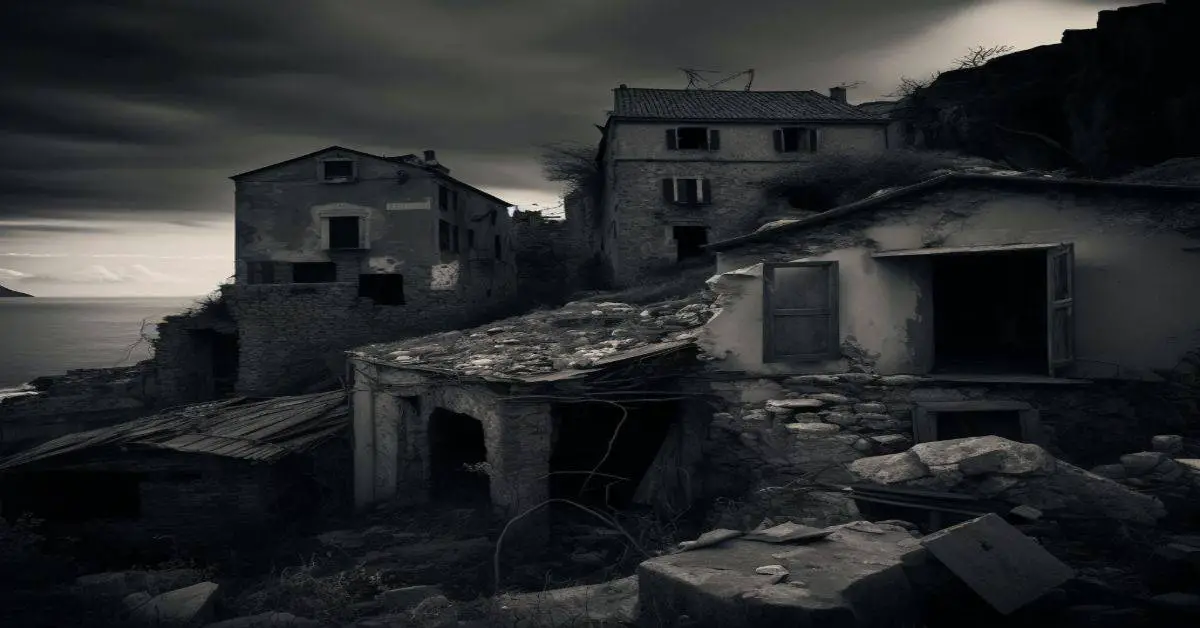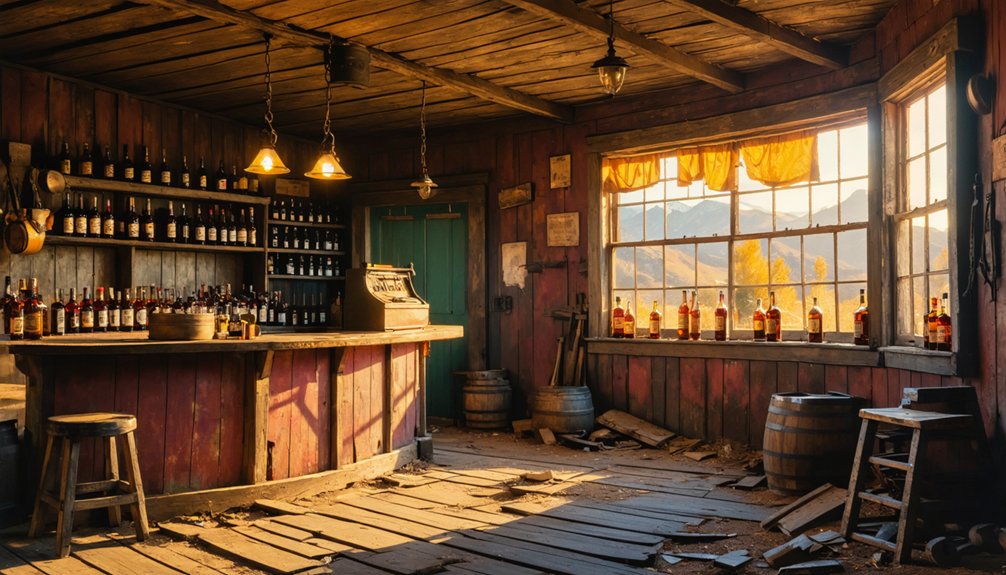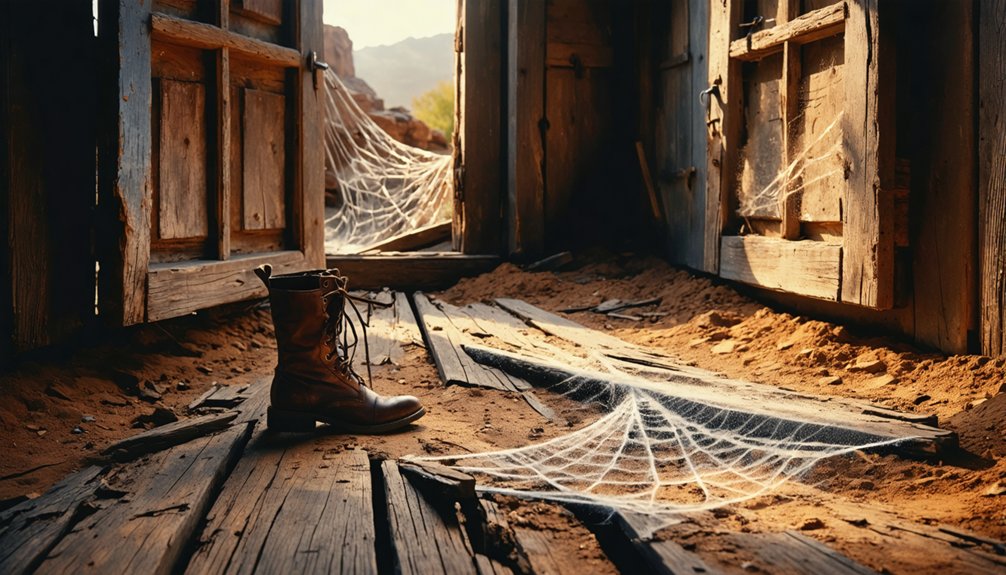California’s most notable ghost towns transport you back to the 1800s Gold Rush era. You’ll find Bodie State Historic Park‘s authentic “arrested decay” preservation, featuring over 100 original structures from its 10,000-resident peak in 1879. Calico Ghost Town offers restored silver mining heritage, while Randsburg remains a living ghost town with active residents. Each site reveals unique glimpses of mining life, from weathered saloons to preserved mine shafts. Further exploration discloses even more fascinating chapters of California’s pioneering spirit.
Key Takeaways
- Bodie State Historic Park stands as California’s most authentic ghost town, featuring over 100 preserved structures and attracting 200,000 visitors annually.
- Calico Ghost Town offers an accessible tourist experience with restored buildings, regular events, and a rich silver mining history.
- Randsburg remains a living ghost town with 69-77 residents, featuring historic buildings, antique shops, and an operating general store.
- Shasta State Historic Park preserves Gold Rush history through its haunting ruins and restored 1861 County Courthouse.
- Cerro Gordo Mines showcases California’s largest historical silver mining operation, complete with aerial trams and extensive underground tunnels.
Exploring California’s Mining Heritage Through Ghost Towns
While California’s landscape today features thriving cities and suburbs, its ghost towns stand as silent reminders to the state’s dramatic mining heritage.
These abandoned settlements tell the story of the Gold Rush era that began in 1848, when thousands of fortune seekers established temporary camps throughout the Sierra foothills.
From tent cities to ghost towns, the Sierra foothills echo with tales of desperate dreamers seeking California’s golden promise.
You’ll discover how mining techniques evolved from simple placer mining to massive hydraulic operations that carved out canyons 600 feet deep at sites like Malakoff Diggins.
Ghost town lore extends beyond gold – from the silver mines of Cerro Gordo that helped build Los Angeles to the short-lived boom of Greenwater in Death Valley. A more recent addition is Eagle Mountain, where Kaiser Steel Corporation transformed a barren desert into California’s largest iron mining operation until its closure in 1983. With almost 300 ghost towns scattered across California, these historic sites offer countless opportunities for exploration.
Some towns, like Columbia, have transformed into living museums, while others remain frozen in time, accessible only by foot through rugged terrain.
The Historic Charm of Bodie State Park
Standing as California’s most authentic ghost town, Bodie State Historic Park preserves the remains of a once-bustling gold mining settlement that peaked at nearly 10,000 residents in 1879.
The town’s rich Bodie history began in 1859 when prospectors discovered gold, but it wasn’t until 1876 that a profitable ore vein transformed it into a thriving community.
Today, you’ll find over 100 original structures maintained in “arrested decay,” offering an unparalleled glimpse into 19th-century mining technology and daily life.
The town earned its infamous reputation from the numerous breweries and saloons that lined its streets, contributing to its notoriety as a lawless frontier settlement.
The site’s preserved buildings – from the Miners’ Union Hall to residential cabins and mining infrastructure – tell the story of boom-era California.
While the town’s final residents departed in 1942, Bodie now welcomes 200,000 annual visitors to explore its authentically preserved streets and buildings. Visitors can take a self-guided tour book for $3.00 to learn more about the historic structures and their significance.
Calico: From Silver Strike to Tourist Delight
Located in California’s Mojave Desert, Calico emerged as a prosperous silver mining town after four prospectors discovered rich deposits on the southern slopes of the Calico Mountains in 1881.
The Silver King Mine quickly became California’s largest silver producer, establishing Calico’s Silver Legacy with over 500 mines yielding $20 million in silver ore.
At its peak, you’d have found a thriving community of up to 2,500 residents, complete with 24 saloons, schools, and cultural institutions.
However, when silver prices plummeted in the 1890s, Calico joined the ranks of California’s ghost towns.
Today, thanks to Walter Knott’s 1950s restoration efforts, you can explore five original buildings and numerous reconstructed structures. Visitors can enjoy daily tours from 9 AM to 5 PM.
As California’s official Silver Rush Ghost Town, Calico now operates as a regional park, preserving its mining heritage for modern visitors. The park hosts exciting events throughout the year, including the popular Civil War Reenactment every President’s Day Weekend.
Randsburg’s Living Ghost Town Experience
While many ghost towns stand empty, you’ll find Randsburg uniquely alive with its historic mining legacy dating back to the 1895 gold discovery that sparked a population boom of 3,500 residents.
You can still experience daily desert town life among the 69-77 current residents who maintain the town’s century-old buildings, including operational businesses and homes with modern amenities. The town’s famous Black Bart sundae draws visitors to its historic establishments. The area’s rich mining history produced an impressive $60 million in gold during its peak years.
The Joint’s Western charm lives on through attractions like the 1904 soda fountain at the General Store, the White House Saloon frequented by miners and off-roaders, and the preserved two-room jail that welcomes curious explorers.
Historic Mining Legacy Lives
As the legacy of California’s mining era endures, Randsburg stands as a symbol of the region’s rich mineral heritage, evolving from a bustling 1890s boomtown into today’s living ghost town.
The area’s Rand Schist and monzonite geology created ideal conditions for mineral deposits. After gold’s discovery in Goler Wash sparked the initial rush, Randsburg mining operations diversified beyond precious metals. You’ll find a story of adaptation, from early placer mining challenges to the district’s emergence as an essential tungsten legacy during wartime production at Atolia.
The Santa Fe Railroad‘s arrival in 1897 transformed the remote camp into a thriving district, processing over $20 million in gold. Visitors can experience the town’s rich history during the annual Western Days Celebration in September.
Though the Kelly silver mine’s closure in 1929 marked the end of an era, Randsburg’s historic operations tell a tale of resilience, spanning gold, silver, and tungsten production through multiple wars.
Daily Desert Town Life
Today’s Randsburg presents a remarkable contrast between its historic peak of 3,500 residents in 1899 and its current population of just 45 recorded in 2020.
You’ll discover a thriving desert culture where antique shops, a historic saloon, and a general store maintain the town’s authentic character. The rural setting between Death Valley and the Sierra Nevada offers a perfect backdrop for experiencing local traditions, including the annual Old West Day celebration each September.
- Visit the desert museum to explore regional exhibits and artifacts
- Enjoy old-fashioned sodas at the general store while browsing local art
- Experience period gunfights and live music during Old West Day
- Explore abandoned structures that tell tales of the town’s mining heritage
Despite its small population, Randsburg’s blend of active businesses and historic structures creates an engaging environment for visitors seeking authentic Western experiences.
The Joint’s Western Charm
Surviving the boom-and-bust cycles of California’s mining era, Randsburg stands as one of the state’s most authentic living ghost towns.
You’ll find its western aesthetics remarkably preserved, with a population that hovers between 69-77 residents maintaining the town’s historic character. The historic preservation efforts have kept landmarks like the two-room jail, White House Saloon, and 1904 General Store virtually unchanged over the past century, save for the addition of electricity.
Today, you can experience this time capsule while enjoying modern amenities.
The town’s historic buildings now serve as both tourist attractions and functional spaces, with some available as Airbnb rentals. Whether you’re cooling off in the historic saloon after a day of off-road riding or exploring the desert museum, Randsburg offers an immersive old West experience.
Hidden Treasures of Cerro Gordo Mines
The rich history of Cerro Gordo Mines began in 1865 when Mexican prospectors Pablo Flores and his companions discovered silver deposits near Buena Vista Peak.
You’ll find one of California’s most significant mining operations, which became the state’s largest silver and lead producer by 1869.
Cerro Gordo’s secrets include an extensive network of underground workings and pioneering mining machinery that revolutionized ore extraction.
- A remarkable aerial tram system built in 1911 spanning six miles to transport ore
- More than 30 miles of underground tunnels revealing the mine’s vast scale
- Production worth $17 million in historical value ($400 million in 2013)
- Two smelters at Cerro Gordo and one at Owens Lake marking industrial innovation
The site transformed from silver and lead production to become America’s largest zinc carbonate producer during 1911-1919.
The Time Capsule of Shasta State Historic Park
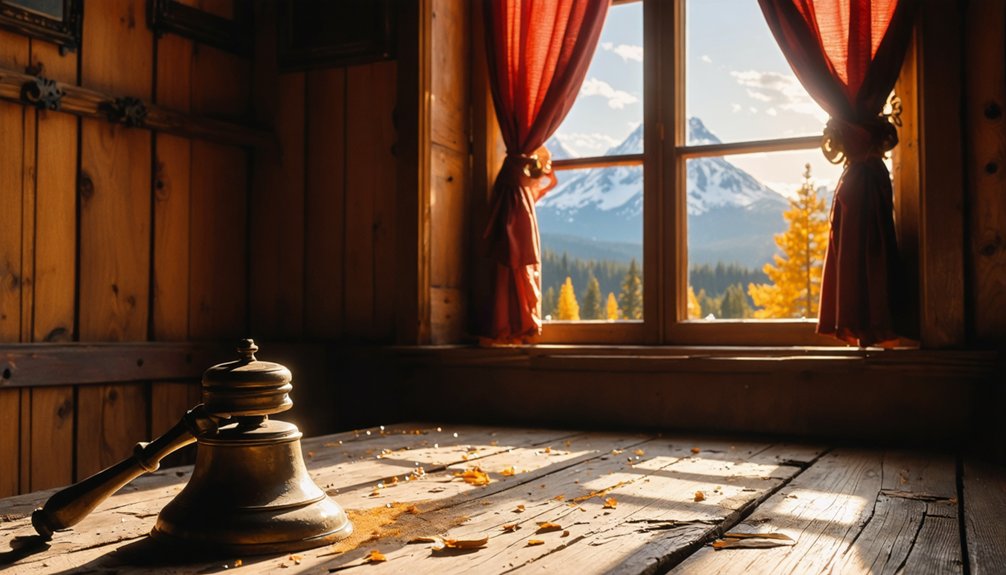
Once a bustling Gold Rush boomtown founded in 1849, Shasta State Historic Park stands as a remarkable homage to California’s mining heritage. Known as the “Queen City” of the northern mining district, you’ll find yourself stepping into a time capsule exploration of the 1850-1890 era, when the town served as a crucial supply hub for ambitious prospectors.
Today, you can wander through the haunting ruins of brick buildings with their distinctive iron shutters, a reflection of historical architecture that emerged after devastating fires.
The restored 1861 County Courthouse showcases period artwork and exhibits, while the row of roofless structures along Highway 299 silently tells stories of merchant life.
The Shasta Historical Society’s preservation efforts since 1930 have guaranteed that this ghost town’s legacy endures, complete with Pioneer Baby’s Grave and Wintu tribal history.
Ballarat: Desert Solitude and Mining Tales
Nestled at the base of California’s Panamint Mountains, Ballarat emerged in 1897 as an essential supply hub for prospectors braving the harsh desert terrain.
Ballarat rose from the unforgiving Mojave sands, a lifeline for those who dared chase desert gold beneath the Panamint peaks.
Named after an Australian gold district, this mining town quickly grew to 500 residents, offering seven saloons, three hotels, and crucial services for fortune seekers.
The Ballarat history reflects the untamed spirit of the American West, where legendary figures like “Shorty” Harris and “Seldom Seen” Slim carved out their desert legacy.
- Experience extreme desert conditions with summer temperatures reaching 120 degrees
- Explore remains of adobe structures and the historic cemetery
- Visit the lone general store run by “Roc,” the town’s single permanent resident
- Walk the same grounds where mining legends once sought their fortunes in the surrounding canyons
Today, Ballarat stands as a symbol of California’s rugged mining era, its weathered remains telling tales of boom-and-bust dreams.
Planning Your Ghost Town Road Trip Adventure
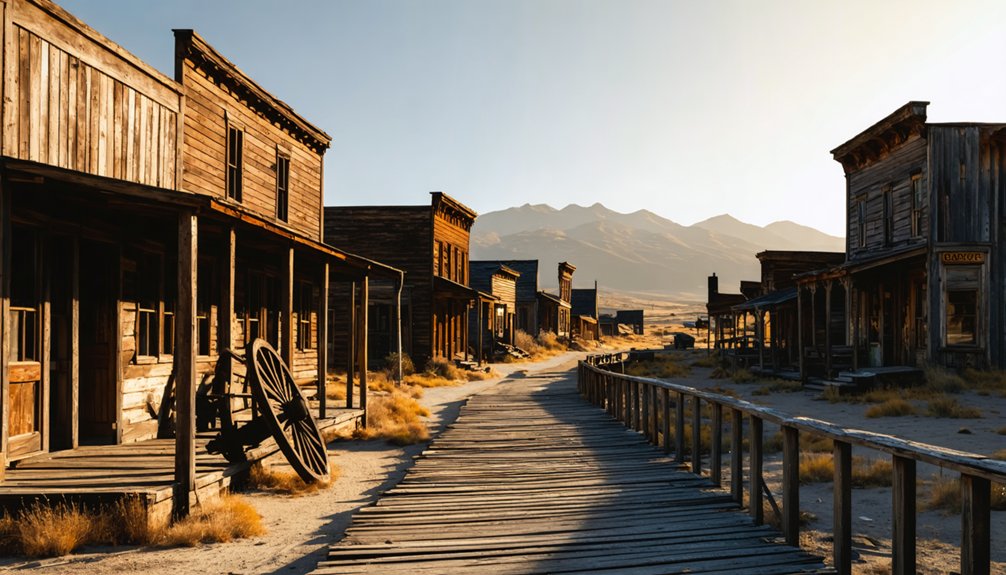
Planning a California ghost town expedition requires careful preparation across vast desert landscapes and remote mountain terrain.
You’ll need a reliable high-clearance vehicle for rugged dirt tracks like Cerro Gordo’s 4-mile ascent, plus adequate food and water since most sites lack concessions.
Several route options accommodate your ghost town photography interests, from the 500-mile scenic loop through Calico to Bodie, to Highway 395’s 400-mile backbone connecting multiple historic sites.
For ideal viewing of historic artifacts, consider the 9-stop northern route beginning at Shasta State Historic Park, or explore the Mojave Desert’s abandoned outposts.
The 1,600-mile Central California loop offers diverse landscapes from coast to desert.
Pack for extreme conditions, as you’ll encounter high desert elevations exceeding 8,000 feet at Bodie and harsh Mojave environments throughout your journey.
Preservation Efforts and Historical Significance
California’s robust state protection programs safeguard ghost towns through mechanisms like the “arrested decay” preservation policy, which you’ll find expertly implemented at Bodie State Historic Park.
You’ll observe how these preservation efforts focus on stabilizing original structures and artifacts while maintaining their weathered authenticity rather than fully restoring them to pristine condition.
The state’s commitment to preserving mining heritage extends beyond physical conservation to include partnerships with nonprofit organizations, universities, and volunteer groups that help document and protect these valuable historical sites.
State Protection Programs
The state’s extensive protection programs for ghost towns represent essential preservation initiatives launched through various agencies and funding mechanisms.
You’ll find California’s commitment to ghost town preservation reflected in programs like the State Historic Rehabilitation Tax Credit, which launches in 2024, offering financial incentives for rehabilitating historic structures.
The Mills Act Program and Certified Local Government Program provide additional support through tax reductions and preservation grants.
- The State Historic Rehabilitation Tax Credit supports preservation of historic properties through state tax incentives
- Mills Act participants receive property tax reductions for maintaining historic character
- Certified Local Government grants fund preservation planning and surveys
- Federal partnerships expand funding options through National Park Service and Getty Conservation Institute
Mining Heritage Restoration
Mining heritage restoration across California showcases diverse approaches to preserving the state’s gold and silver rush legacies.
You’ll find contrasting preservation models, from Bodie’s “arrested decay” maintaining 200 original structures to Calico’s commercialized restoration by Walter Knott. At Empire Mine, you can explore extensive mining equipment displays and a scale model of 367 miles of tunnels that yielded 5.6 million ounces of gold.
Modern restoration efforts range from state-funded programs to private initiatives.
The Bodie Foundation’s “Save Bodie” campaign protects ghost town architecture through targeted repairs, while at Cerro Gordo, you’ll witness an individual owner’s documented restoration reaching millions of viewers.
Malakoff Diggins preserves both buildings and environmental impact sites, offering insight into hydraulic mining’s lasting effects on California’s landscape.
Safety Tips for Ghost Town Exploration
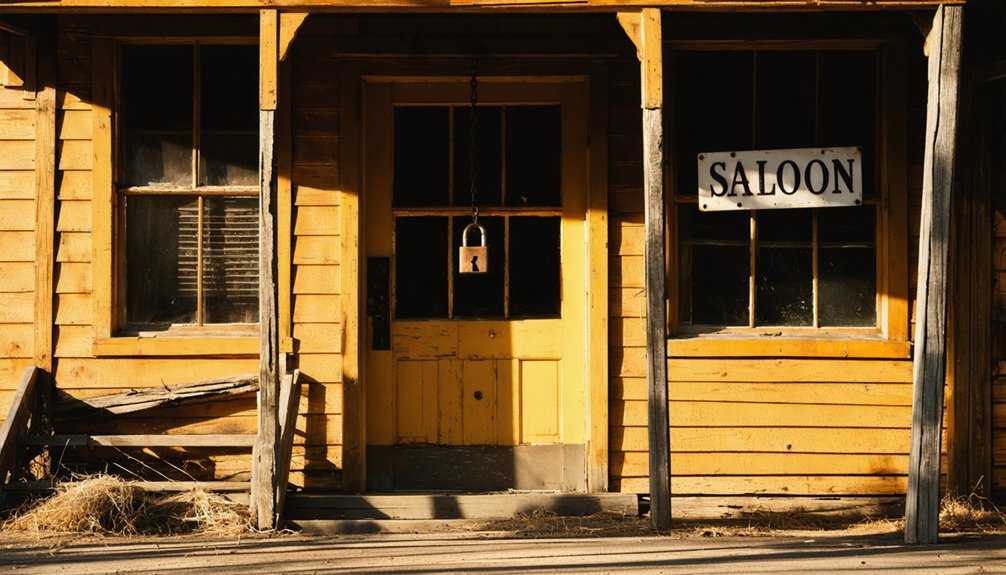
Exploring abandoned ghost towns requires thorough preparation and adherence to strict safety protocols due to hazardous conditions and remote locations. At elevations reaching 8,375 feet, you’ll need proper safety gear and wildlife awareness when venturing into these historic sites.
Before departure, check weather forecasts and road conditions, as seasonal extremes can create hazardous situations.
- Pack essential survival items including maps, compass, GPS, water, food, and appropriate clothing layers
- Travel in groups and bring vehicle recovery equipment for self-rescue situations
- Stay clear of unstable mine structures and never remove artifacts from protected sites
- Follow Tread Lightly principles and respect property boundaries while preserving historic locations
Remember that cell service is limited and park services are minimal, so your preparation and responsible conduct guarantee both your safety and the preservation of these valuable heritage sites.
Frequently Asked Questions
Are There Any Reported Ghost Sightings in These Abandoned Mining Towns?
You’ll find documented ghost stories and paranormal investigations only at Calico Ghost Town, which offers haunted house attractions and ghost tours. The other mining towns don’t have verified supernatural reports.
Can Visitors Collect Artifacts or Rocks From Ghost Town Sites?
You’re strictly prohibited from collecting any artifacts or rocks at ghost town sites. Visitor regulations protect these locations for preservation, and removing items is illegal under state and federal laws.
What’s the Best Time of Year to Photograph California Ghost Towns?
While you might think summer’s ideal, you’ll get your best shots in winter months. Visit Calico December through February and Bodie in early mornings year-round for prime lighting and fewer crowds.
Do Any Ghost Towns Offer Overnight Camping or Accommodation Options?
You’ll find camping options at Calico Ghost Town’s RV park and cabins, Pioneertown’s camping sites and motel, while Cerro Gordo offers volunteer-based accommodation. Most other ghost towns don’t allow overnight stays.
Are Metal Detectors Allowed in California’s Ghost Town Historic Sites?
You’ll face strict metal detecting regulations at most ghost towns due to historical preservation concerns. You’ll need permits for federal sites, while private ghost towns like Cerro Gordo may allow organized detecting events.
References
- https://whimsysoul.com/must-see-california-ghost-towns-explore-forgotten-histories/
- https://www.visitcalifornia.com/road-trips/ghost-towns/
- https://en.wikipedia.org/wiki/List_of_ghost_towns_in_California
- https://www.tripadvisor.com/Attractions-g28926-Activities-c47-t14-California.html
- https://californiahighsierra.com/trips/explore-ghost-towns-of-the-high-sierra/
- https://www.youtube.com/watch?v=3AkK0gKGmmg
- https://dornsife.usc.edu/magazine/echoes-in-the-dust/
- https://www.islands.com/1878743/one-lagest-ghost-towns-eerily-modern-abandoned-california-mining-town-eagle-mountain/
- https://westernmininghistory.com/state/california/
- https://www.youtube.com/watch?v=O5pS_gVKqFQ
